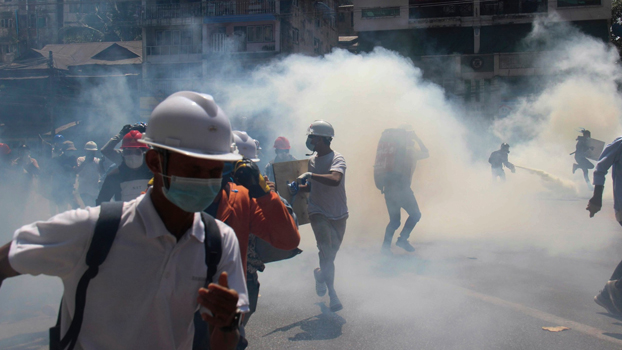Defying lethal shootings, Myanmar protesters back on streets

Police in Myanmar’s biggest city on Monday fired tear gas at defiant crowds who returned to the streets to protest the military’s seizure of power a month ago, despite reports that security forces had killed at least 18 people around the country a day earlier, reports AP from Yangon, Myanmar.
The protesters in Yangon were chased as they tried to gather at their usual meeting spot at the Hledan Center intersection. Demonstrators scattered and sought to rinse their faces with water in vain attempts to ease the irritating effects of the gas.
In the capital, Naypyitaw, the country’s ousted leader Aung San Suu Kyi made a court appearance Monday via videoconference, the independent Myanmar Now online news agency reported. It said she received a charge under Section 505(b) of the Penal Code for allegedly inciting unrest.
Further details of the court appearance were not immediately available.
Suu Kyi had already been charged with two other offenses — possession of walkie-talkies that had been imported without being registered, and violating an order issued under the Natural Disaster Management Law limiting public gatherings in order to fight the spread of the coronavirus.
The 75-year-old Suu Kyi was initially detained by the military at her Naypyitaw residence, but fellow members of her National League for Democracy party are uncertain of her present whereabouts. If she is convicted, the charges against her could provide a legal way of barring her from running in the election the junta has promised in a year’s time.
At least five people were believed to have been killed Sunday in Yangon when police shot at the protesters, who are demanding that Suu Kyi's elected government be restored to power after being ousted in a Feb. 1 coup. The protesters' civil disobedience movement has adhered so far to the the tenets of nonviolence despite provocation from the security forces and pro-military counter-demonstrators.
People erected makeshift sidewalk shrines at the spots where several of the victims were shot and also paid their respects by standing outside the hospitals from which the bodies of the victims were being released to their families.
In Dawei, a small city in southeastern Myanmar where an estimated five people were killed Sunday, the number of protesters on the streets Monday was lower than usual. Marchers there split into smaller groups, parading through the city to the applause of bystanders who also made the three-finger salutes adopted by the resistance movement to show their support.
The coup reversed years of slow progress toward democracy in Myanmar after five decades of military rule. Suu Kyi’s party would have been installed for a second five-year term in office, but the army blocked Parliament from convening and detained her and President Win Myint, as well as other top members of Suu Kyi’s government.
The U.N. said it had “credible information” that at least 18 people were killed and 30 were wounded around Myanmar on Sunday. Counts made by other sources, such the Democratic Voice of Burma, an independent television and online news outlet, put the death toll in the 20s.
Any of those reports would make it the highest single-day death toll since the military takeover.
“Deaths reportedly occurred as a result of live ammunition fired into crowds in Yangon, Dawei, Mandalay, Myeik, Bago and Pokokku,” the U.N. Human Rights Office said in a statement, referring to several cities, adding that the forces also used tear gas, flash-bang grenades and stun grenades.
Confirming the deaths of protesters has been difficult amid the chaos and general lack of news from official sources, especially in areas outside Yangon, Mandalay and Naypyitaw, the capital. But in many cases, photos and video circulated showed circumstances of the killings and gruesome photos of bodies.



